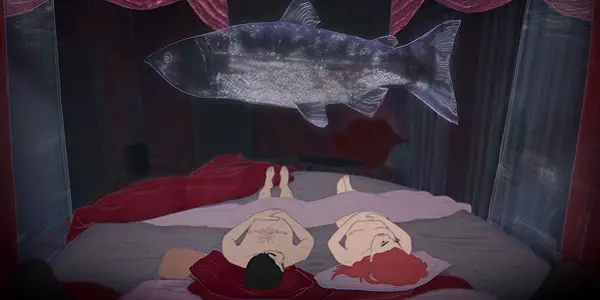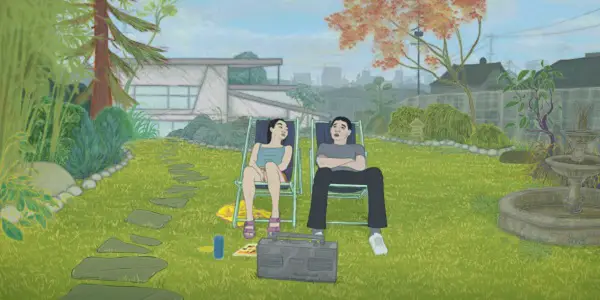BLIND WILLOW, SLEEPING WOMAN: The Magical World Of Murakami

Lee Jutton has directed short films starring a killer toaster,…
There have been few film adaptations of author Haruki Murakami’s work, though perhaps that is for the best. His writing, which mixes the mundanity of everyday life with hefty dashes of the supernatural to create magical realist worlds, is immediately recognizable as his and his alone; to attempt to recreate this unique form of enchantment on screen is to almost guarantee that something will be lost in translation. (And yes, I am aware that this is ironic considering everything of Murakami’s that I have read has itself been a translation.) It’s not surprising that the most internationally acclaimed adaptations of Murakami’s writing — Lee Chang-dong’s Burning (2018) and Ryusuke Hamaguchi’s Drive My Car (2021) — are both based on stories that are more grounded in the real world than many of his others and expand those stories’ sparse narratives so robustly that the films stand on their own as singular pieces of art.
But Blind Willow, Sleeping Woman is different. The feature debut of director, composer, and artist Pierre Földes (whose father, Peter Földes, was a pioneer of computer animation), the film adapts half a dozen of Murakami’s short stories from across three different collections to tell an episodic story of the struggle to find human connection in a dreary, disconnected world. But this is no ordinary world: there is a man-sized talking frog who wants to wage war with a giant underground worm, a mysterious box that may or may not only contain air, a reclusive restaurant owner who claims to be able to grant wishes, and much more. In other words, it is unmistakably Murakami, rendered visually stunning by some delightfully surreal animation.
After the Quake
Blind Willow, Sleeping Woman takes place in the aftermath of the earthquake and tsunami that struck Japan in March 2011; the two stories that comprise the bulk of the film’s plot, “UFO in Kashiro” and “Super-Frog Saves Tokyo,” come from Murakami’s collection after the quake, which was written in response to the 1995 Kobe earthquake. The tragedy ignites an existential crisis inside each of the three main characters in the film: middle-aged bank employee Katagiri (voiced by Marcelo Arroyo), his younger colleague Komura (Ryan Bommarito), and Komura’s wife, Kyoko (Shoshana Wilder).

Kyoko is unable to drag herself away from the television, where she stays up all night watching endless news about the earthquake; shortly afterward, she leaves Komura, telling him that living with him is like living with “a chunk of air.” Komura finds himself reexamining their relationship, including its origins in the tragic death of his best friend and Kyoko’s first love, before seizing the opportunity to hand-deliver a mysterious box to a friend’s sister in the northern city of Hokkaido. Meanwhile, Katagiri is confronted by the aforementioned Frog (voiced by Földes), who insists that Katagiri come cheer him on in Frog’s battle royale against the worm that caused the earthquake; if the worm wins, another earthquake is bound to happen soon, and this one will likely be even more deadly than the first.
Hard-Boiled Wonderland
Földes’ adaptation is clever; the meat of all of the original stories remains intact on screen, but instead of keeping them as entirely separate narratives, Földes links them by distilling their various characters down into this small group of protagonists who recur throughout the film. Kyoko is not the original protagonist of the short story “Birthday Girl,” in which a woman recalls the elderly restaurant owner who offered to grant her one wish on her twentieth birthday, but it makes sense for her to be; it works in the context of her individual story arc and the film as a whole.

Murakami agreed to allow Földes to adapt his work after being impressed by the artist’s visual renderings, and indeed, the distinctive animation style of Blind Willow, Sleeping Woman is the film’s greatest strength and an ideal match for the tone of Murakami‘s storytelling. The main characters are fully fleshed out in line and color, while the miscellaneous passersby in the background are little more than semi-transparent shadows; one can almost believe that they are representations of the lives lost in the earthquake, ghosts going about their everyday lives as though they don’t even know they are dead. Sometimes the scenery, too, is extraordinarily minimalist, keeping the focus on the main characters and the tales they are telling. There are psychedelic dream sequences, a missing cat that glows royal blue, and a tree that sends flies to pollinate inside a woman’s ear, yet as rendered visually by the film’s animators, and narratively by Murakami’s writing, all of these surreal moments feel much closer to real life than one would initially think.

That being said, I was not a huge fan of most of the voice performances in the film; with the exception of Földes himself and his energetic performance as Frog (not Mr. Frog, mind you — just Frog), many of the actors sound as though they are sleepwalking through their parts. Perhaps this was part of the intention, considering the dreamlike nature of so many scenes in the film, but the result was that I found it difficult to remain attentive when certain characters were speaking. Fortunately, the stories themselves are so fascinating that one manages to remain engaged with the film regardless. The first thing I ever read by Murakami was The Wind-Up Bird Chronicle, and it remains my favorite; the short story that would go on to be that book’s first chapter, “The Wind-up Bird and Tuesday’s Women,” is adapted here by Földes in such a lovely, haunting way that I’d be intrigued to see him tackle a full adaptation of the novel.
Conclusion
Fans of Murakami‘s inimitable style will be pleasantly amazed at how well Blind Willow, Sleeping Woman brings his magical world to life.
Blind Willow, Sleeping Woman opens April 14, 2023 at Film Forum in New York.
Watch Blind Willow, Sleeping Woman
Does content like this matter to you?
Become a Member and support film journalism. Unlock access to all of Film Inquiry`s great articles. Join a community of like-minded readers who are passionate about cinema - get access to our private members Network, give back to independent filmmakers, and more.
Lee Jutton has directed short films starring a killer toaster, a killer Christmas tree, and a not-killer leopard. Her writing has appeared in publications such as Film School Rejects, Bitch: A Feminist Response to Pop Culture, Bitch Flicks, TV Fanatic, and Just Press Play. When not watching, making, or writing about films, she can usually be found on Twitter obsessing over soccer, BTS, and her cat.













